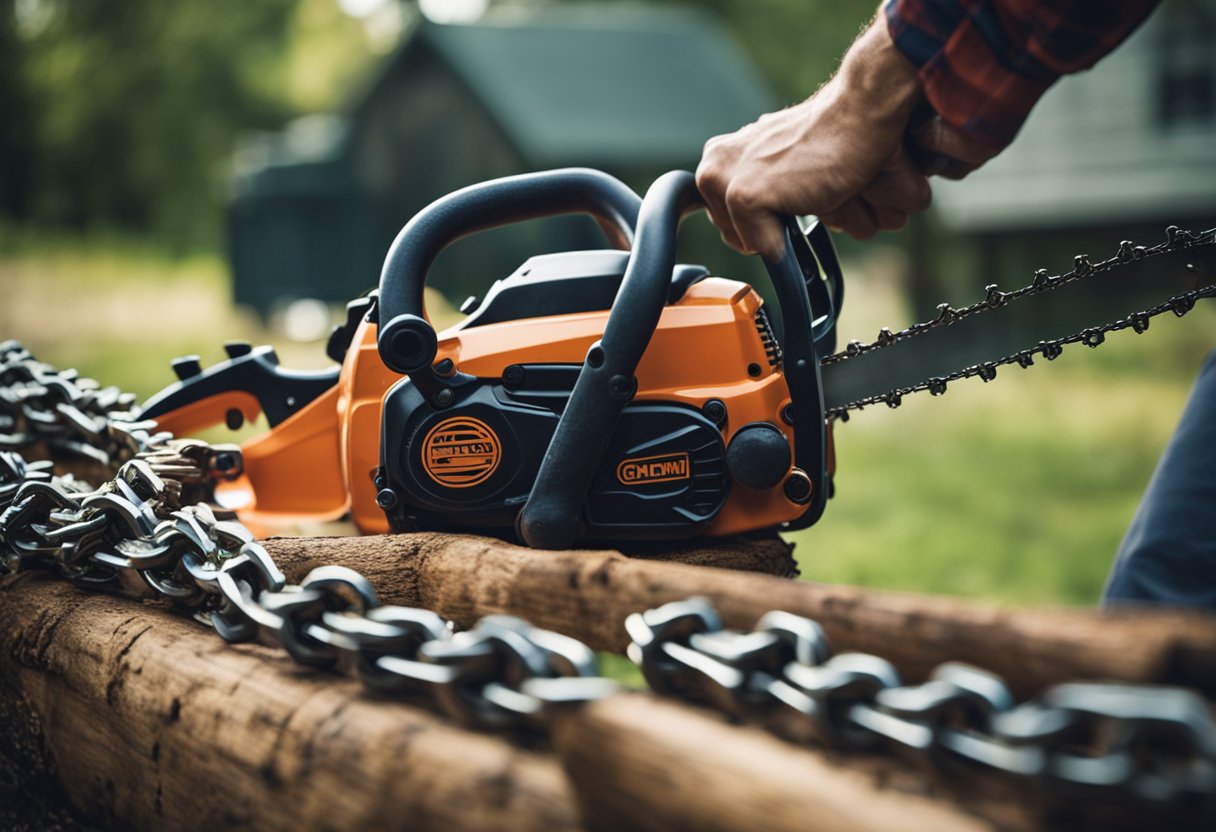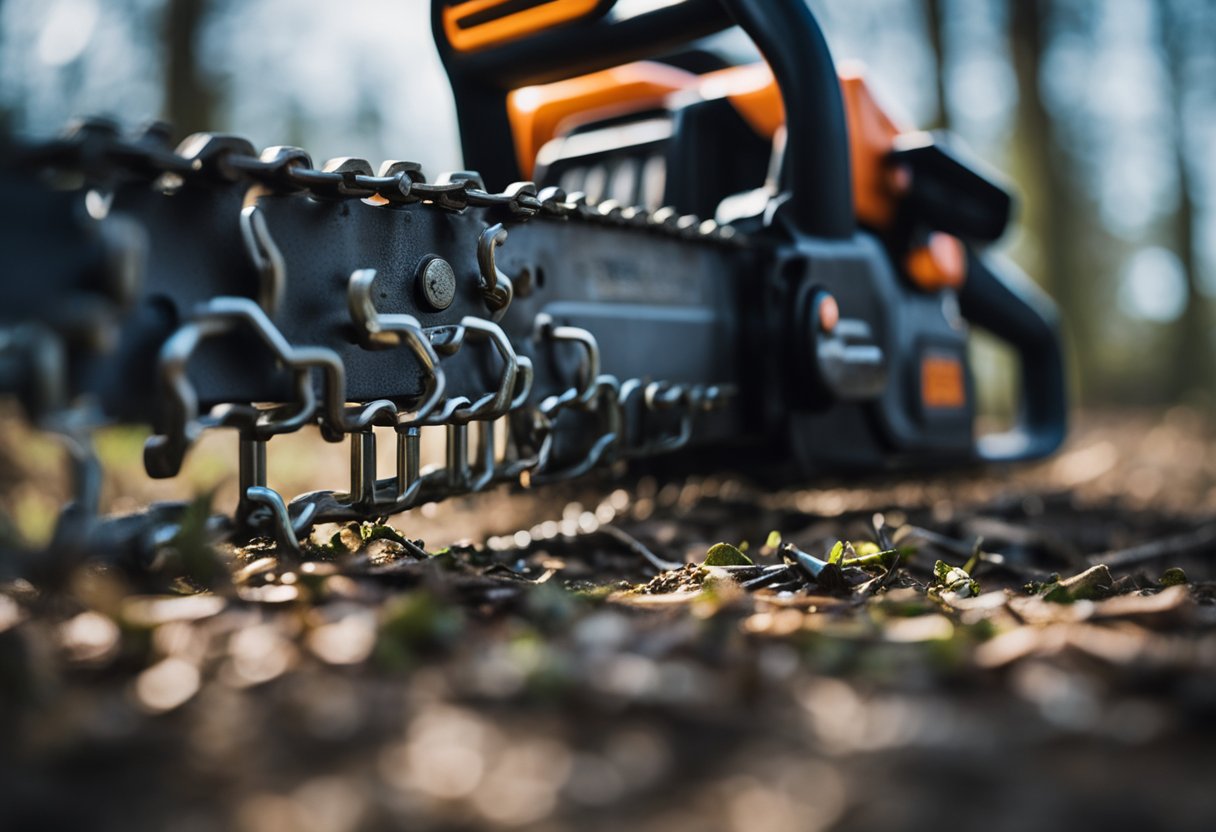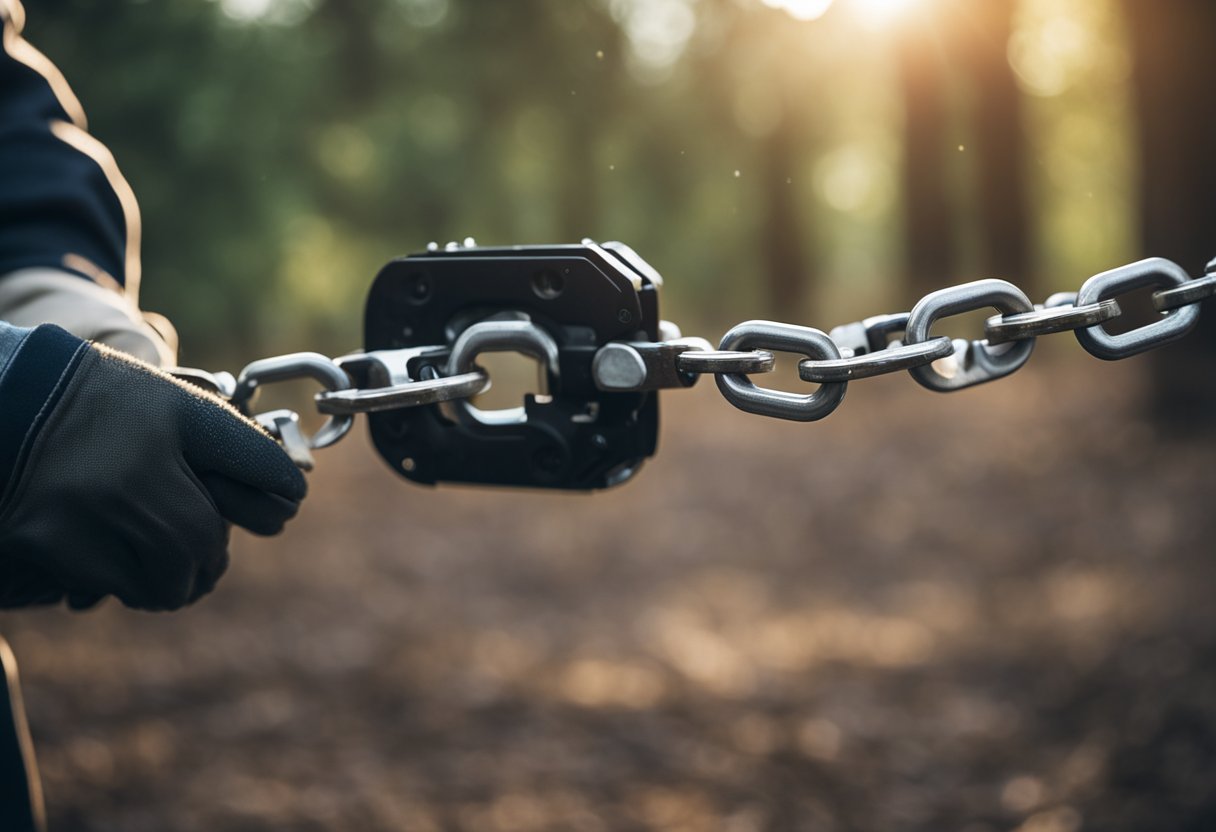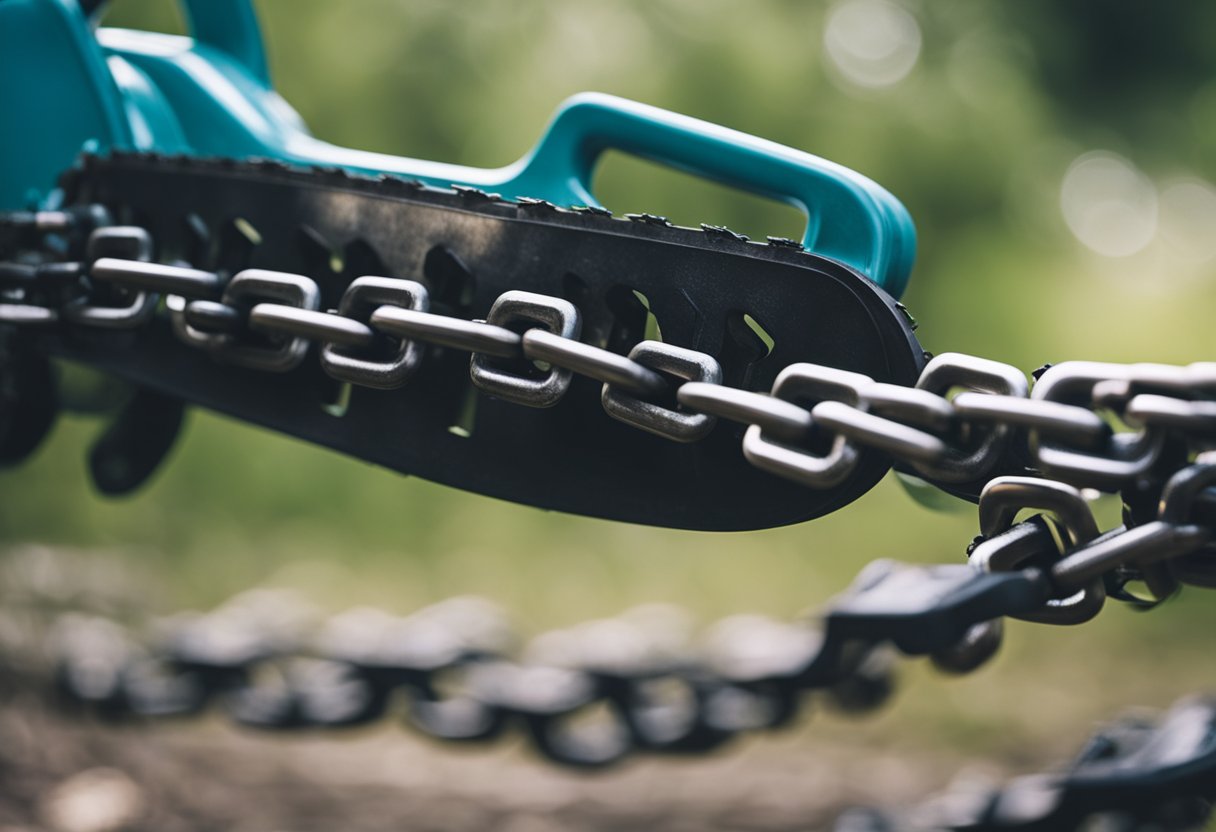If you’re an avid chainsaw user, you know how frustrating it can be when your chainsaw chain won’t move by hand. There are several reasons why this might happen, ranging from simple issues like excess tension or debris in the guide bar to more complex problems like a damaged clutch or engine. In this article, I will guide you on how to troubleshoot your chainsaw and identify the root cause of the problem.
Understanding the chainsaw chain is the first step in troubleshooting the issue. The chainsaw chain is made up of several components, including the drive links, cutters, and tie straps. These components work together to cut through wood and other materials. However, if any of these components are damaged or worn out, the chain won’t move as it should. By identifying the different parts of the chainsaw chain, you can better understand how to troubleshoot the problem.
Common reasons why the chainsaw chain won’t move include excess tension, debris in the guide bar, a worn-out clutch, and a damaged engine. Identifying the root cause of the problem is essential in determining the best course of action. In the following sections, we will discuss how to troubleshoot these issues and provide tips on how to maintain and repair your chainsaw chain to prevent future problems.
Key Takeaways
- Understanding the chainsaw chain is essential in troubleshooting the issue.
- Common reasons why the chainsaw chain won’t move include excess tension, debris in the guide bar, a worn-out clutch, and a damaged engine.
- Identifying the root cause of the problem is essential in determining the best course of action.
Understanding the Chainsaw Chain
https://www.youtube.com/watch?v=iY-qgN6StuQ&embed=true
As a chainsaw operator, it’s important to understand the components of your tool, especially the chainsaw chain. The chain is an essential part of the chainsaw that rotates around the guide bar to cut through wood. Understanding how the chainsaw chain works can help you troubleshoot problems such as when the chain won’t move by hand.
The chainsaw chain has several components, including the cutting teeth, depth gauges, and drive links. The cutting teeth are the sharp edges that cut through the wood, while the depth gauges regulate the depth of the cut. The drive links are what connect the chain to the chainsaw’s engine, allowing it to move.
When the chainsaw chain won’t move by hand, it could be due to several reasons. One common reason is that the chain is too tight or loose. A tight chain can cause excessive friction, leading to the chain not moving, while a loose chain can cause the chain to slip off the guide bar.
Another reason why the chainsaw chain won’t move by hand is due to debris or dirt buildup in the guide bar. This can cause the chain to become stuck, preventing it from moving. In such cases, cleaning the guide bar and removing any debris can help solve the problem.
Additionally, a worn-out clutch can also cause the chainsaw chain not to move. The clutch is responsible for engaging and disengaging the chain, and if it’s worn out or damaged, it can prevent the chain from moving.
In conclusion, understanding the chainsaw chain is essential for any operator. Knowing the components of the chain and how it works can help troubleshoot problems when the chain won’t move by hand. By ensuring that the chain is properly tensioned, cleaning the guide bar, and checking the clutch, you can keep your chainsaw running smoothly.
Common Reasons Why Chainsaw Chain Won’t Move
https://www.youtube.com/watch?v=J-prLqbCobk&embed=true
As a chainsaw owner, it can be frustrating when the chainsaw chain won’t move by hand. There are several reasons why this might happen, and it’s important to identify the root cause of the problem to fix it.
Clutch and Sprocket Issues
One of the most common reasons why a chainsaw chain won’t move is due to clutch and sprocket issues. The clutch assembly and sprocket work together to engage the chain and make it turn. If the clutch shoes or the sprocket teeth are worn-out, the chain won’t turn. It’s important to regularly check the clutch shoes and sprocket teeth for wear and replace them as necessary.
Chain Brake Engagement
Another reason why a chainsaw chain won’t move is due to the chain brake engagement. The chain brake is a safety feature that stops the chain from turning when the chainsaw is not in use. If the chain brake is engaged, the chain won’t move by hand. To disengage the chain brake, pull the chain brake handle towards the rear handle of the chainsaw.
Chain Tension and Lubrication
Chain tension and lubrication are also crucial factors that can affect the movement of the chainsaw chain. If the chain tension is too tight, the chain won’t move. On the other hand, if the chain tension is too loose, the chain may come off the bar. It’s important to adjust the chain tension according to the manufacturer’s instructions.
Additionally, if the bar and chain are not sufficiently lubricated, the chain can become stiff and difficult to move. Make sure to regularly check the chain oil level and refill it as necessary.
Engine and Carburetor Problems
Finally, engine and carburetor problems can also cause the chainsaw chain to not move. If the idle speed is too low, the chain won’t turn. Additionally, if the centrifugal clutch is not engaging properly, the chain won’t move. It’s important to regularly maintain the engine and carburetor to prevent these issues.
In summary, a chainsaw chain that won’t move can be caused by a variety of factors. By regularly maintaining the clutch, sprocket, chain brake, chain tension, lubrication, engine, and carburetor, you can prevent these issues and ensure that your chainsaw is always in good working condition.
Identifying Damage and Troubleshooting
https://www.youtube.com/watch?v=8fmnCm8SVYM&embed=true
As a chainsaw owner, it’s important to know how to identify damage and troubleshoot issues with your chainsaw chain. In this section, I will provide some tips on how to assess damage and troubleshoot issues that may arise with your chainsaw chain.
Assessing Damage
Before you can troubleshoot any issues with your chainsaw chain, you need to assess whether there is any damage. Here are some signs of damage to look out for:
-
Broken or missing teeth: If you notice any broken or missing teeth on your chainsaw chain, it’s a sign that the chain is damaged and needs to be repaired or replaced. A broken or missing tooth can cause the chain to skip or jump, which can be dangerous.
-
Stuck chain: If your chainsaw chain is stuck and won’t move, it’s likely due to damage or debris in the guide bar. You can try to remove any debris that may be causing the chain to stick, but if the problem persists, the chain may need to be repaired or replaced.
-
Worn-out clutch: If your chainsaw chain won’t move by hand, it could be due to a worn-out clutch. A worn-out clutch can cause the chain to slip or not engage properly. You can check the clutch by removing the sprocket cover and inspecting the clutch drum and clutch shoes for wear.
Troubleshooting Steps
Once you have identified any damage to your chainsaw chain, you can begin troubleshooting the issue. Here are some steps you can take to troubleshoot your chainsaw chain:
-
Check the tension: If your chainsaw chain won’t move by hand, it could be due to excess tension. You can check the tension by loosening the chain tensioner and adjusting the tension to the manufacturer’s specifications.
-
Inspect the guide bar: If your chainsaw chain won’t move by hand, it could be due to debris in the guide bar. You can inspect the guide bar for any debris and remove it if necessary.
-
Check the lubrication: If your chainsaw chain won’t move by hand, it could be due to a lack of lubrication. You can check the lubrication by inspecting the oil level and ensuring that the oil is flowing properly to the chain.
-
Replace the chain: If your chainsaw chain is damaged beyond repair, you will need to replace it. You can purchase a replacement chain from your local hardware store or online.
By following these troubleshooting steps, you can identify and repair any issues with your chainsaw chain. Remember to always prioritize safety when working with chainsaws and to wear appropriate protective gear.
Maintenance and Repair
https://www.youtube.com/watch?v=GUEzxbrM65Y&embed=true
As a chainsaw owner, it is important to perform routine maintenance to ensure your chainsaw operates smoothly and safely. Regular maintenance can also help prevent issues such as a chainsaw chain that won’t move by hand. In this section, I will cover routine maintenance and repair and replacement of parts.
Routine Maintenance
Routine maintenance is essential to keep your chainsaw in good condition. Here are a few things you can do to maintain your chainsaw:
-
Check the chain oil: Make sure the chain oil reservoir is full before each use. A lack of oil can cause the chain to become stiff and difficult to move.
-
Check the spark plug: A dirty or fouled spark plug can cause starting problems, which can lead to issues with the chain. Check the spark plug regularly and replace it if necessary.
-
Clean the air filter: A dirty air filter can restrict airflow to the engine, causing it to run poorly. Clean or replace the air filter regularly to keep your chainsaw running smoothly.
-
Use fresh fuel: Old gas can cause starting problems and other issues. Use fresh fuel and store it properly to prevent issues with your chainsaw.
Repair and Replacement
If your chainsaw chain won’t move by hand, it may be time for repair or replacement of parts. Here are a few things to consider:
-
Check the clutch: A worn-out clutch can cause the chain to become stiff and difficult to move. If the clutch is worn, it may need to be replaced.
-
Check the guide bar: Debris in the guide bar can cause the chain to become stuck. Clean the guide bar regularly to prevent this issue.
-
Replace worn parts: Over time, parts such as the chain and guide bar can become worn and need to be replaced. Check these parts regularly and replace them if necessary.
By performing routine maintenance and addressing issues promptly, you can keep your chainsaw running smoothly and prevent issues such as a chainsaw chain that won’t move by hand.
Sharpening the Chainsaw Chain
https://www.youtube.com/watch?v=Ca-0Yd6uAKc&embed=true
Sharpening the chainsaw chain is an essential maintenance task that ensures the chain remains sharp and cuts efficiently. A dull chain can cause the engine to work harder, leading to premature wear and tear on the chainsaw. Here are some tips to sharpen the chainsaw chain effectively:
1. Check the Chain Tension
Before sharpening the chain, it’s essential to check the chain tension. A loose chain can cause the chain to skip or derail, while a tight chain can cause excessive wear on the bar and sprocket. To check the chain tension, turn off the chainsaw and release the chain brake. Then, use a screwdriver to adjust the tension until the chain fits snugly against the bar.
2. Use the Correct File Size
Each chainsaw chain has a specific size and type of file that should be used for sharpening. Using the incorrect file size can lead to uneven teeth and poor cutting performance. To determine the correct file size, refer to the chainsaw’s owner’s manual or consult a professional.
3. Sharpen the Cutters
The cutters are the teeth on the chainsaw chain that do the cutting. To sharpen the cutters, hold the file at a 30-degree angle and file each tooth from the inside out. Use a smooth, even stroke, and file until the tooth is sharp and shiny. Then, move on to the next tooth and repeat the process.
4. File the Rakers
The rakers are the small bumps in front of each cutter that control the depth of the cut. To file the rakers, use a flat file and file each raker down to the depth gauge line. Be careful not to file too much or too little, as this can affect the chain’s cutting performance.
5. Maintain Consistent Tooth Length
It’s essential to maintain consistent tooth length across the chain to ensure even cutting performance. To do this, count the number of strokes it takes to sharpen each tooth and use the same number of strokes on each tooth. This will help maintain uniform tooth length and ensure the chain cuts evenly.
In conclusion, sharpening the chainsaw chain is a crucial maintenance task that ensures the chainsaw operates efficiently. By following these tips, you can sharpen the chainsaw chain effectively and ensure it cuts smoothly and evenly.
Safety Measures and Efficiency
When it comes to handling a chainsaw, safety should always be a top priority. Before attempting to troubleshoot why your chainsaw chain won’t move by hand, it’s important to take the necessary precautions. I always wear the appropriate safety gear, including eye and ear protection, gloves, and sturdy boots.
In addition to safety, efficiency is also important. A chainsaw that isn’t working properly can slow down your work and even cause damage to the saw. To ensure maximum efficiency, it’s important to keep the guide bar and bar groove clean and free of debris. I always check the rail slot for any damage or wear and tear, as this can also cause the chain to malfunction.
One safety mechanism that can cause the chainsaw chain to not move is the chain brake. If the chain brake is engaged, the chain won’t move. I always make sure to disengage the chain brake before attempting to troubleshoot any other issues.
Another factor that can affect the efficiency of your chainsaw is the type of wood you’re cutting. Harder woods can put more strain on the chain and cause it to wear out faster. If you’re cutting firewood, make sure to choose a chainsaw with a chain that’s designed for that purpose.
By taking these safety measures and ensuring maximum efficiency, you can troubleshoot why your chainsaw chain won’t move by hand and get back to work quickly and safely.
Conclusion
In conclusion, there are several reasons why a chainsaw chain won’t move by hand. It could be due to excess tension, debris in the guide bar, or a worn-out clutch. Always ensure safety first, then troubleshoot.
One of the most common reasons why a chainsaw chain won’t move by hand is a lack of proper lubrication. The chains require regular lubrication to ensure smooth movement and reduce friction. Without adequate lubrication, the chain can become stiff and difficult to move. It is important to regularly check the oil reservoir and use the appropriate bar and chain oil to ensure proper lubrication.
Another reason why a chainsaw chain won’t move by hand is a worn-out clutch cover. The clutch cover can become worn over time, causing the chain to bind and preventing it from rotating. It is important to regularly check the clutch cover and replace it if necessary.
Additionally, a chainsaw chain won’t move by hand if the spark plug wire is disconnected or faulty. The spark plug wire provides the necessary spark to ignite the fuel in the engine. If the wire is disconnected or faulty, the engine won’t start and the chain won’t move.
Finally, a chainsaw chain won’t move by hand if the rotating parts are stuck or damaged. The starter rope, clutch pads, and sprocket can become stuck or damaged, preventing the chain from rotating. It is important to regularly inspect these parts and replace them if necessary.
By understanding these common issues and taking the necessary precautions, you can troubleshoot and fix a chainsaw chain that won’t move by hand. Always prioritize safety and follow the manufacturer’s instructions when troubleshooting and repairing your chainsaw.
Frequently Asked Questions
What causes a chainsaw to lock up?
A chainsaw may lock up due to a variety of reasons such as a damaged or worn-out chain, a seized engine, or a malfunctioning clutch. It is important to troubleshoot the issue to determine the root cause of the problem before attempting to fix it.
Why won’t the chainsaw chain move by hand?
If the chainsaw chain won’t move by hand, it could be due to excess tension, debris in the guide bar, or a worn-out clutch. Always ensure safety first, then troubleshoot the issue.
How do I fix a chainsaw clutch that isn’t engaging?
If the chainsaw clutch isn’t engaging, it could be due to a worn-out clutch, a damaged sprocket, or a malfunctioning chain brake. To fix the issue, you may need to replace the clutch assembly or the sprocket, or adjust the chain brake.
Why is my chainsaw chain binding?
A chainsaw chain may bind due to a variety of reasons such as a damaged or worn-out chain, a loose or damaged guide bar, or a malfunctioning clutch. It is important to troubleshoot the issue to determine the root cause of the problem before attempting to fix it.
What should I do if my chainsaw chain is stuck in a tree?
If your chainsaw chain is stuck in a tree, turn off the chainsaw and wait for the chain to stop moving. Then, use a pry bar or a wedge to free the chain from the tree. Avoid using the chainsaw to force the chain out of the tree as this can damage the chain or the guide bar.
How do I troubleshoot an electric chainsaw chain that’s not turning?
If your electric chainsaw chain is not turning, it could be due to a variety of reasons such as a damaged or worn-out chain, a malfunctioning clutch, or a faulty motor. To troubleshoot the issue, check the chain tension, inspect the chain for damage, and check the clutch and motor for proper function.

Hi, I’m Sal Muller of Tooltrip.com. My DIY experience led me to understand essential power tools for home projects. Tooltrip.com guides enthusiasts and professionals in choosing right tools for any job. I provide concise top tool reviews for easier, efficient DIY.





